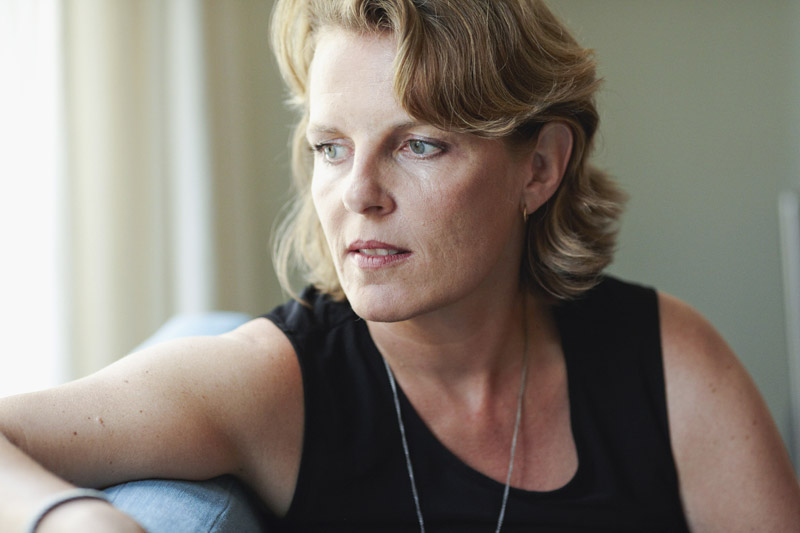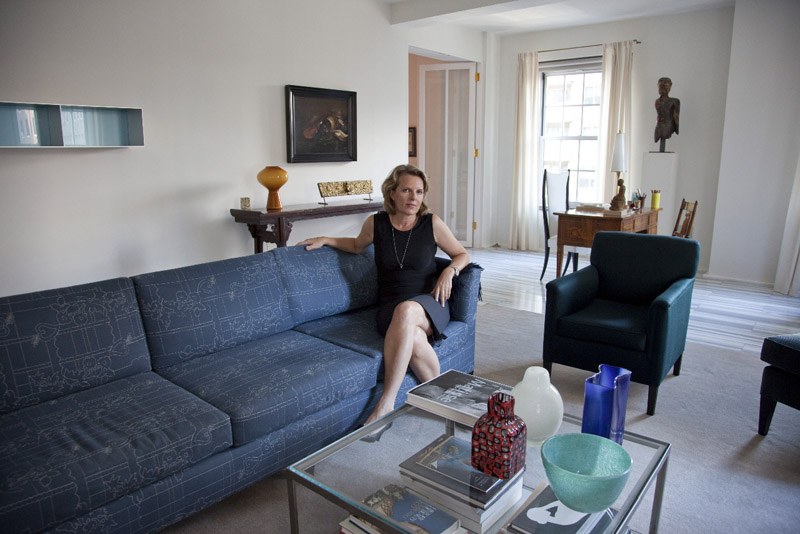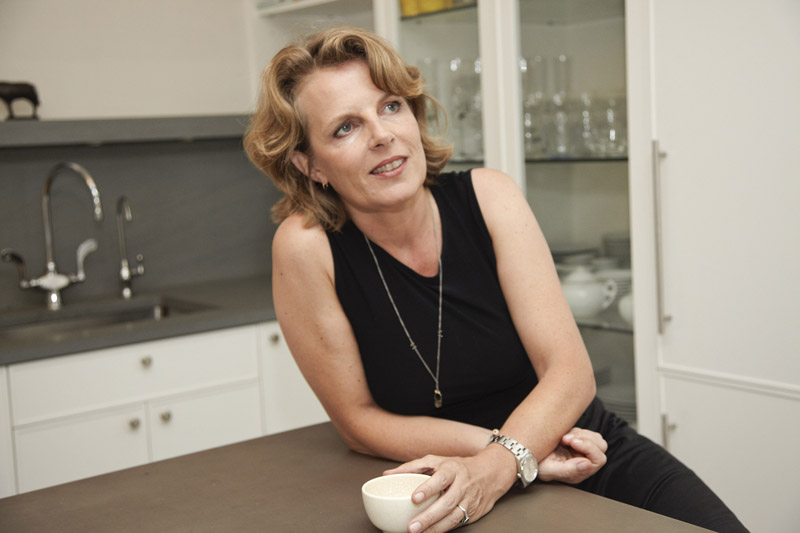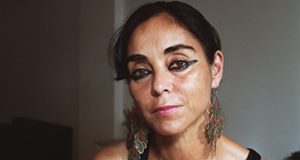

Annabelle_1

Annabelle_6

Annabelle_5

Annabelle_3

Annabelle_2

Annabelle_4
“BUILDING OUTSIDE THE BOX”
One of the most original voices in architecture today, Annabelle Selldorf, defies convention in service to art.
Interview by Amy Routman / Photographed by Lina Bertucci
AR: As an architect, I am often looking at spaces for art. I am fascinated by the potential dynamics between art forms – the interesting interplay between architectural space and the art installed.
Should a gallery space be neutral to allow the artwork to be in the foreground? Or, should it be a challenging space for the artist, and engaging for the viewer?
The Neue Galerie in New York City, a favorite place to view art, merges the neoclassicism of the pre-existing building with the modern style of its early 20th century German and Austrian collection. Restored by the German-born architect Annabelle Selldorf, the building makes use of the context and specificity that is representational of her approach to design. Her spaces do not compete with the art they contain. Rather, through the use of space, material, and light, her work provides a restrained context for viewing art.
In her career of over twenty years, Selldorf has created numerous spaces for art: galleries, museums, and spaces for artists and collectors. As a favorite architect within the art world, she has worked on projects that house some of the world’s most noteworthy artwork. Her work includes projects like the Neue Galerie on Fifth Avenue, a Venetian Palazzo for an arts foundation, and galleries for Barbara Gladstone, David Zwirner and Hauser & Wirth. Her work has been described as subtle, precise, and thoughtful.
Following is a conversation with Selldorf about her work, her process, and spaces for art.
AR: How do you gauge the success of a project?
AS: There are different kinds of success: Is it in my architectural thinking, a well-rounded project? Does it live up to the standards that I have set for myself? Is it in sync with my philosophy? And, of course, is it successful in terms of whether it was built to the satisfaction of the client, budget, and schedule. And, significantly, is it a quality project? It’s a combination of all of those things. You are obviously unhappy if it turns out to be an ugly monster, but that’s bound not to happen if you have anything to do with it throughout. Client satisfaction, budget, and schedule are, in a way, harder to anticipate. Did you communicate well with your client about how long it would take, [and] what the requirements were, and did you listen to them carefully enough?
AR: Does the project need to be built to be considered successful or of value?
AS: There could be a component of success if it is not built but, by and large, yes. I think it is of value for me when it all comes together. You distinctly feel that something is missing if you put your heart and soul into designing a building or a project of some kind and then it doesn’t get realized. There is something missing. Also, if you’ve built a beautiful building, but you’ve had a major falling out with a client, you just have a hard time remembering it positively.
AR: After each project do you assess what went well or didn’t for future projects?
AS: Sometimes we do, more or less formally. I think it is a very good discipline within the office because you can kind of assess [how you] functioned. But I think it takes longer. It is like when you read a book and you remember years later certain qualities about it that resonate within you. It is a little bit like that.
AR: Looking at your project list I see a long history of working on art-related commissions. Why did you end up in that particular building type or genre–or was it a conscious choice?
AS: Maybe a little bit of both! I am very interested in art. I often find that looking at art is reciprocally inspiring. And the less formal part–or less considered part–is because I knew a lot of art dealers and they knew that I knew the artists and the art. So, I was kind of the logical choice for somebody to work with. And then, the more I learned about doing art related projects, the more I realized how much I enjoyed it — in a way it distilled my way of thinking. It is very much about making clear, well- proportioned spaces in which looking at art is possible. Viewing art is supported by the kind of space I make.
AR: Has the museum and gallery work changed your attitudes regarding art?
AS: It teaches you to see more! Not so much that it changes, but with each thing that that you see, you learn something. I suppose it deepens your point of view rather than changes it.
AR: Did your year in Florence influence your approach to designing spaces for art or, for that matter, to looking at the art itself?
AS: I don’t think specifically. But I think for me the most important thing in art, and also in my work, is seeing and absorbing what you see. All these experiences contribute.
AR: You’ve designed studios for artists, galleries, museums, collectors, and for yourself. For each of these projects where art is installed, are there common threads or is there a different attitude with each?
AS: I think that my work is specific. In as much as it is specific, it is different for each project. What is common, of course, is my way of thinking about things and so what reoccurs is certain themes about how I approach things that always have to do with space, with daylight, etc. But specificity means that I listen carefully to the requirements that someone else may have. For example, the different galleries that I have designed are very different from one another as result of different approaches that a specific dealer may have to the way they want to show art. And what makes things interesting is, on one hand, the degree of specificity that you can bring to a project is directly is linked to how carefully you can listen to somebody. But what they have in common is my way of analyzing and finding solutions. And so I am always the common thread in a project.
AR: You have the project at the Clark Institute in Williamstown. Are there any innovations there that you are introducing? Is there a certain complexity to that type of project that is different programmatically?
AS: Well, it is an interesting project. The Clark is a museum in the Berkshires that was conceived by Sterling and Francine Clark, and the building that houses the permanent collection was built in 1955. The museum is difficult to describe in that it is clad in marble and has a sort of temple resemblance. Yet, on the inside, there is a domestic scale to it despite the fact that actually it is not a small building. So, it is a very odd building with different qualities that simply work very well–though when you think about it analytically, these things don’t go well together. So the mandate was to bring coherence to the museum while expanding it and improving lighting, and doing this with a really light hand in order to make the museum look better than it ever looked, without taking away the quintessential comfort that the building suggests to people who go there. This is a very abstract mandate because one could say, okay I’ll simply continue doing things the way they were, or I could think about it more philosophically–I don’t know if that is the right term—[asking]: What are the essential qualities and how can you build on those while questioning those qualities that are less successful or less coherent? So I think we are doing the latter, expanding the museum a little, albeit in ways that make people feel that it was perfectly evident that the museum is continued in this way. It is an exercise in understanding a vocabulary. It’s a non-egotistical project. I like things like that. I think it is very interesting because once again it has to do with precision, and at the same time with the confidence that I can make a contribution that is not in the first place about leaving a signature.
AR: Is it similar to your work in the Neue Galerie?
AS: In some ways. I think restoration projects tend to be that way. You need to be very clear about what you want to do and not slavishly subscribe to the existing fabric. But it is not about you in the first place.
AR: Does a collection play a strong role in your organization of spaces?
AS: That involves really working closely with the curators. Yet, it is obviously interesting, important, and indispensable that you know and understand the collection. But, more than anything, you have to really be very clear that the intention of the curators is what you need to understand.
AS: With the economy the way it is now, how do you see large-scale museum projects coming up in the future?
AS: You hear me chuckle. It’s a slightly desperate chuckle, perhaps. I don’t know. I can’t actually answer that. I know that there are projects out there. The economy is difficult but there are people out there who are willing to dedicate themselves to cultural projects. And that is great. I think if they happen they will be less frequent and in some ways that is good. The proliferation of sort of useless megalomaniacal projects perhaps will be curbed a little bit. On the other hand, you want there to be a flow of thinking, and I think culture is very important— its always has been. But now, in a way, people are much more conscious of the contribution that the cultural exchange plays in everyday life. Depending on the time of day you ask me, I’m guardedly optimistic.
AR: In different eras museums evoked different experiences: as temples to worship art, places of education, cabinets of curiosities; they entertained, educated, delighted & surprised. What is the role of the museum now?
AS: First, I think it is all of those things and I think it is a beautiful question because I imagine there is room and necessity for all of it. Personally, I am less interested in entertainment than I am in the didactic and educational aspects of it– but that sounds very academic. Yet, I think the function of a museum to communicate depth and context of culture is really something that you don’t want to lose. So, it depends of course on the museum. In New York we have a Museum of Sex. I drive by in a taxi from time to time. I wonder whether it would be worth going into. But I have so far resisted the temptation. And there must be a place for things like that because it still apparently [has existed] for a long period of time. And I sometimes wonder: Who goes there? What do they do there? What do they learn?
AR: Are there other places, other galleries and museums that you’ve taken things away from, or that have inspired you?
AS: Always and all the time! I’m terribly interested in what other people do and how other people see things. And I try not to be judgmental, [but rather] take things in and absorb them–it is what formulates one’s own point of view.
I am constantly inspired or interested in really different points of view. Take, recently, Zaha Hadid’s museum in Rome, the MAXXI development. I think that it looks like an incredibly interesting museum. But it appears that exhibiting art there is a different type of task– it is not conventional.
AR: Zaha Hadid has gotten away from the white cube spaces organized in file cabinet-like order–is it her various paths and the feeling of discovery that intrigues you?
AS: It certainly intrigues me. It is entirely possible to do that kind of thing, but it requires a different kind of process or thinking than what comes natural to me. I’m not critical of it, quite the opposite, it has made me think that good space—interesting space—can only ever make things more interesting. While it is not my own approach, that way of thinking is entirely inspiring.
AR: The Sims Metal Management recycling center project in Brooklyn seems to be a departure from your previous residential and institutional work. What drew you to this project?
AS: As an architect you always want to learn about new things and discover the possibilities that you have working at different scales. I myself was quite surprised that we were chosen in a limited competition to do this project. In this particular case it is a much larger scope and [the] focus is not specifically about the proportion of interior space but it is more of a master plan sort of thing, so that is very interesting. There are plenty of things to learn and there are new materials like solar panels, and that is a learning process, definitely. It is a great thing to find there [exists] an interest in bringing design considerations to public projects. Heretofore, those kinds of projects were done purely to get the job done with the least expense. It is wonderful to see that there are people out there now who say that a well-designed project brings more to the community than something that just merely fulfills economic considerations.
AR: It seems like this is a more European approach to this kind of project than that which you typically see in the States.
AS: That is true. I think that in the States we sort of lag behind a little with considerations of the community or considerations of sustainability. But, as has been proven over and over again, once this kind of thinking is incorporated in a larger frame of reference, we seem to catch up pretty quickly– and it is really great to see that has been the case.
AR: Do find that your rhetorical skills help you realize your projects? Do you feel that being able to communicate is as important as other factors in actualizing your design?
AS: I think that experience helps [with the ability] to articulate your thoughts to a client. Even communicating your goals and your point of view to your own team is ever important. The longer I do that the more I learn about [its] importance. So, my answer is quite simply, ‘Yes.’
AR: Did you observe any of this in your father’s work or career as an architect?
AS: Yes, I observed my father, but oddly enough when I went into architecture I did much of that intuitively.
AR: Did his design aesthetic influence you?
AS: Very much so. The older I get the more I realize it. There are certain ways of thinking about things that you absorb [in] childhood.
AR: Do you think that would be the case even if he hadn’t been an architect–a certain way of thinking and looking at things?
AS: What I think I learned from my father and family is the importance of seeing and absorbing, and formulating an opinion. And that is certainly something that was very present in my upbringing.
AR: Do you think that can be taught?
AS: Yes, very much so.
AR: In what way?
AS: In learning to pay attention, learning to make sure that you see things. It is a process of consciousness, but it is definitely something that you can teach. Many people tend take whatever is around them for granted. Some people are perhaps are like that naturally. But the older I get the more I think it is something that one can consciously learn [to do].
AR: How do you keep expanding your work and your vision—keeping yourself inspired? Do you have certain daily routines to guide your life and work or creativity? Do you do anything that helps you keep yourself open to seeing?
AS: To some extent it is inexplicable. It is mix of that which is rational and that which is intuitive. I think you learn to have a certain discipline in going about questioning and being analytical. I believe that architecture has a utilitarian purpose at its heart. But it is also the mother of all arts! So it is the dialogue between what is intuitive and that which is rational that I’m interested in. I am a great believer in knowledge and experience in order to understand precedent, because I think that there is little that we can invent. But sorting through the complexities of issues that present themselves as you are doing a project and finding a path to unfold your own narrative and fantasies is what brings creativity. So I think that rather than relying on some wonderful idea coming into my head, there are ways that you can jog that. You can size up a project and understand what the frame of reference is. And then your fantasy reveals itself. And it is also critical to have process with yourself.
AR: Were there certain turning points where things opened up and you saw things differently and your career took off in an unexpected direction?
AS: It used to be that I wasn’t very goal oriented. That is perhaps a funny way of saying it, but it seemed that things occurred and I didn’t make a choice– I just followed where they led me. Whereas now, I am a probably more conscious just because I have been doing this for a very long time, so I have greater confidence in saying: ‘I want to explore this’ or ‘I want to do something else.’ It is also very different than as a younger practitioner when I was more or less on my own with fewer people to work with. You go about things very differently than you do when you have the context of a larger office with different people contributing, and you have to to feed your own office. There is a certain responsibility. Some part of that responsibility is that you want to keep yourself and others interested in the next thing. You don’t want to do just an endless repetition of projects that are alike.
AR: Did you ever search for female architect role models? Did you get any encouragement along the way?
AS: No, not specifically, though I think again that the longer you do something the more you sort of think about those things. I am pleased to see so many competent, successful colleagues out there. The playing field is much wider than it used to be. But it is not at all what I thought about when I started. People always ask me: ‘How do you think a woman architect is different from a male architect?’ and I used to say ‘I’ve never been male so I don’t know how.’ And I still think that is a little bit true, though now I am very aware of the fact that women think about things a little differently. They approach things differently. I don’t think men like to hear that. Women are more able of finding consensus– more interested in dialogue. I don’t so much subscribe to the model of architect-hero who works solitarily and comes out with the grand idea. I think that architecture is very much a collaborative process and on your own there is very little you can do, but that does not preclude taking strong leadership.
AR: Alvaro Siza has said that there is pressure with so much architecture to do everything very quickly. He says “…but the computer does not think for you, and the time it takes us to think does not change.” (New York Times, August 5, 2007) Do you agree?
AS: One hundred percent! I am fairly inept on the computer. And it has really not made any difference to my thinking. That may be good or bad, but for the most part it just is the way it is. I think that thinking and seeing are very private activities and they move at the pace at which you can absorb them or turn them out.
AR: Do you feel that students now coming out of architecture school have more computer experience, but less hand-drawing experience–does it affect the type of work being done?
AS: I think it is mostly just different. I am incredibly impressed at how immensely sophisticated students are, and how their ability to obtain information is so vastly expanded with the aid of the computer and internet. Also impressive is their knowledge of the tools to disseminate that information into ways of communicating onward. So, that being not my own process and these not being my own tools, I sometimes feel that I am on the outside looking in. I find I’m vastly overwhelmed by how much people can do. I’ve yet to be convinced that [this technology] produces greater depth in thinking, but it certainly had changed how we practice.
AR: How has new technology impacted your office and what you are able to do?
AS: The process of collaborating and interacting is now much more important because other people have different competencies and different abilities they bring to the table.
AR: Do you see yourself as more of a critic within the office?
AS: No, not at all. I am equal part instigator and critic, and that is very good in that it keeps you fresh. If you could never make room for other people’s thinking you would get stuck in a lonely place. But if you didn’t feel confident and capable of inspiring and of creating, then that would be equally as sad.
AR: What do you consider the most difficult aspect of being Annabelle Selldorf?
AS: I think it is doubt. Doubt is the hardest thing to deal with. I wouldn’t want to be without doubt, because it keeps you critical with yourself. But it sometimes is a battle. Sometimes doubt becomes a hindrance and an obstacle and yet at other times it makes for healthy self-criticism.








